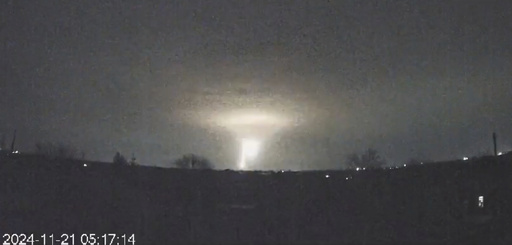A recent launch of a new ballistic missile by Russia has targeted a military-industrial site in Dnipro, Ukraine, signaling a direct message to NATO. Following the missile strike on Thursday, there was an intense discussion regarding whether it was an intercontinental ballistic missile. In a surprising move, President Vladimir Putin appeared on Russian television to clarify details about the missile. Asserting that the new missile is an intermediate-range ballistic weapon, he claimed it sped toward its target at ten times the speed of sound, making it nearly impossible for modern air defense systems, including those supplied by the U.S. in Europe, to intercept it.
This incident marks the first operational deployment of this type of missile in the ongoing conflict. The strike occurred amid escalating tensions between Ukraine and Russia after Ukraine targeted Russian facilities using American long-range missiles, prompted by relaxed American restrictions on their utilization. In reprisal, Putin reduced the threshold for engaging Russia’s nuclear arsenal.
Putin named the missile “Oreshnik,” which translates to “hazelnut tree” in Russian, and highlighted that this was its first successful test in combat. He previously mentioned in July that Russia would ramp up production of intermediate-range missiles as a countermeasure against U.S. plans to deploy similar arms. Describing Oreshnik as a response to Western missile developments, he indicated that these intermediate-range ballistic missiles (IRBMs) are designed to carry heavier payloads, including potential nuclear warheads, and can cover distances ranging from 500 to 5,500 kilometers.
According to Ukrainian military officials, the missile was launched from the Astrakhan region of Russia, located around 800 kilometers from its target. While Russia has previously utilized cruise missiles from distant locations, the introduction of IRBMs in this conflict represents a significant milestone. Analysts noted that the missile’s capability to deliver multiple warheads at hypervelocity could challenge even the most advanced missile defense systems.
The attack showcased six fiery trails followed by powerful explosions in a video that, while unable to be independently verified, suggested multiple warheads were deployed. Experts acknowledged the difficulty in intercepting such high-speed projectiles, even for sophisticated systems like the U.S. Patriot missile defense.
Putin characterized the missile launch as a response to Ukrainian attacks on Russian military locations fueled by Western weaponry, asserting that the conflict now possesses global implications. He has previously cautioned that the usage of Western arms against Russia equates to a state of war between Russia and NATO, insisting on Russia’s right to defend itself vigorously.
Should Russia continue using the Oreshnik missile against Ukrainian targets, Putin stated that prior warnings would be issued to facilitate civilian evacuations, framing it as a humanitarian measure. He expressed little concern over alerting adversaries, emphasizing the ineffectiveness of defenses against such attacks.
Putin’s rhetoric, along with comments from Dmitry Medvedev, deputy secretary of Russia’s Security Council, suggests an intimidation tactic aimed at the West, underscoring Russia’s capabilities in advanced missile technology. Medvedev further condemned the West for its involvement, posting a video of the missile attack and taunting that this was the outcome they sought.
In response to the missile launch, Ukrainian President Volodymyr Zelenskyy condemned the action as indicative of Russia’s urgencies to test its new arsenal, condemning their actions as displaying a lack of respect for human dignity and freedom. Meanwhile, unnamed U.S. officials indicated that Russia’s inventory of such experimental missiles is limited, suggesting that the deployment of these missiles in Ukraine might not become a regular occurrence.
U.K. Defense Secretary John Healey remarked that the conflict had reached a critical period, noting the increased volatility along the front lines compared to earlier in the war. He emphasized the recent surge in attacks on Ukrainian energy infrastructure and civilian populations with devastating impacts as winter approaches, highlighting the deployment of North Korean troops on the front lines as an alarming development.



